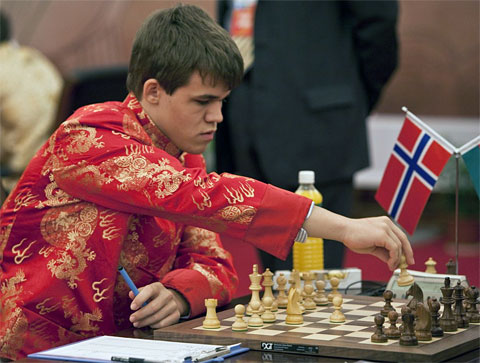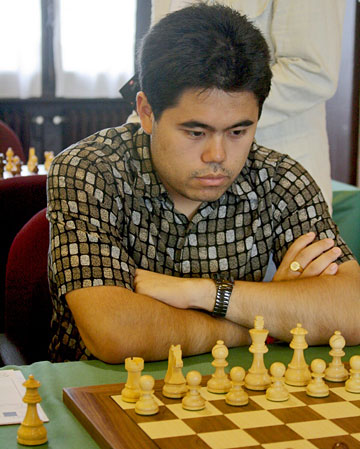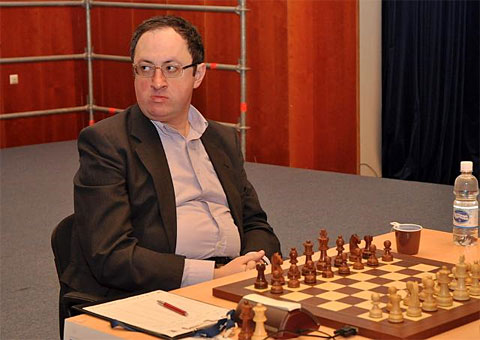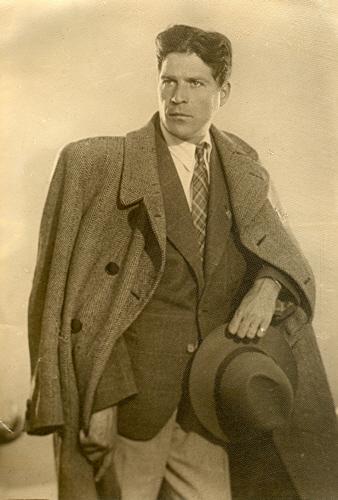| Latest | Greatest | Lobby | Journals | Search | Options | Help | Login |
|
|
|
This topic is archived. |
| Home » Discuss » Topic Forums » Sports |
|
| Jack Rabbit
|
Sun Dec-20-09 03:26 PM Original message |
| The JR Chess Report (December 20): Russian Superfinal Begins in Moscow |
|
Russian Championships Begin
 The "Superfinal" of the Russian national and women's championships began today in Moscow. Ten players each are competing for the national and women's title in two single round robin competitions of nine games than runs through Wednesday, December 30. Vying for the national title are: reigning national champion Peter Svidler, first league champion Denis Khismatullin, reigning European champion Evgeny Tomashevsky, Alexander Grischuk, Sanan Sjugirov, Artyom Timofeev, Dmitry Jakovenko, Evgeny Alekseev, Nakita Vitiugov and Alexander Riazantsev. The ten ladies fighting it out for the women's title are: defending champion Nadezhda Kosintseva, reigning European women's champion Tatiana Kosintseva, reigning Russian girls' champion Valentina Gunina, two-time women's world champion runner-up Alisa Galliamova, new mother Natalia Pogonina, Anastasia Bodnaruk, Tatiana Stepovaia, Elena Zaiatz, Maria Romanko and Maria Manakova. All eyes in the women's tournament are on Natalia Pogonina, who gave birth to a baby boy about a month ago. In the first round completed earlier today in the national competition, Grischuk defeated Tomashevsky in 75 moves and Khrismatullin downed Riazantsev while all other games were drawn. The first round of the women's competition featured a complete set of decisive games. Nadya Kosinteva took down Gunina in 54 moves; Tanya Kosintseva didn't fare as well as her sister, losing to Bodnaruk in 34 moves; Pogonina celebrated her return to chess by defeating Romanko in a spiffy 30 moves; Galliamova beat Stepovaia in 63 moves; and Zaiatz took care of Manakova in a quick 29 moves. The action from Moscow is broadcast live on the website of the Russian Chess Federation everyday until the end of the tournament except Christmas, which is a rest day. Play begins at 3 pm Moscow time (2 am PST). Calendar Hastings Chess Congress 26 December 2009-5 January 2010. Rilton Cup, Stockholm 27 December 2009-5 January 2010. Reggio Emilia Tournament 27 December 2009-4 January 2010. Corus Chess Tournament, Wijk aan Zee 15-31 January 2010. Group A: Anand, Carlsen, Caruana, Dominguez, Ivanchuk, Karjakin, Kramnik, Leko, Nakamura, Shirov, Short, Smmets, Tiviakov and van Wely. Gibraltar Chess Festival 26 January-4 February. Moscow Open 29 January-8 February. Aeroflot Open, Moscow 9-17 February. 27th Ciudad de Linares 12-25 February. European Individual Championships, Rijeka (Croatia) 5-19 March. Russian Team Championships, Dagomys 1=12 April. Anand-Topalov Match for the World Title, Sofia 23 April-10 May. Chess Olympiad, Khanty Mansiysk 19 September-4 October. European Club Cup, Plovdiv 16-24 October. |
| Printer Friendly | Permalink | | Top |
| Jack Rabbit
|
Sun Dec-20-09 03:28 PM Response to Original message |
| 1. This week's games |
|
Your humble hare acknowledges the assistance of Fritz 6.0 on analysis. Diagrams on the Jack Rabbit Chess Report are made with Chess Mérida, a true type font that can be downloaded free here. !""""""""# $tMvWlVmT% $OoOoOoOo% $ + + + +% $+ + + + % $ + + + +% $+ + + + % $pPpPpPpP% $RnBqKbNr% /(((((((() WHITE White to move (This position is a theoretical draw) I would like to thank my impressive and loyal staff: Buccaneer, Spitfire, Swashbuckler, Pancho and Robin Hood. |
| Printer Friendly | Permalink | | Top |
| Jack Rabbit
|
Sun Dec-20-09 03:32 PM Response to Reply #1 |
| 2. London Chess Classic |
| Printer Friendly | Permalink | | Top |
| Jack Rabbit
|
Sun Dec-20-09 03:54 PM Response to Reply #2 |
| 5. Ni Hua - Carlsen, Round 5 |
 Magnus Carlsen Ni Hua - Magnus Carlsen Chess Classic, Round 5 London, 13 December 2009 Spanish Sicilian Game: Rat Defense 1.e4 c5 2.Nf3 d6 3.Bb5+ Nd7 4.d4 a6 5.Bxd7+ Bxd7
6.dxc5
6...dxc5 7.Nc3 e6 8.Bf4
8...Ne7 9.Ne5 Ng6!?
10.Qh5
10...Bc6 11.Bg3 Nxe5 12.Bxe5 c4
13.0-0 Qa5 14.Qg5 h6 15.Qg3 f6
16.Qg6+!
16...Ke7 17.Bf4 Be8
18.Qg3 Kf7 19.Rad1!?
19...Bc6 20.Rd2 !""""""""# $t+ + V T% $+o+ +lO % $o+v+oO O% $W + + + % $ +o+pV +% $+ N + Q % $pPpR PpP% $+ + +rK % /(((((((() WHITE: Ni Hua Position after 20.Rd1d2 20...e5! 21.Be3 Bb4 22.f4 Rhe8 23.f5 Bc5 24.Rfd1 Rad8 25.Rxd8 25...Bxe3+ 26.Qxe3 Rxd8 27.Rxd8 Qxd8 28.Kf2 28...Qd6 29.a3 a5 30.Kf3 30...Kg8 31.g3?!
!""""""""# $ + + +l+% $+o+ + O % $ +vW O O% $O + Op+ % $ +o+p+ +% $P N QkP % $ Pp+ + P% $+ + + + % /(((((((() WHITE: Ni Hua Position after 31.g2g3 31...b5!
32.Ke2
32...b4 33.axb4 axb4 34.Nd1 Ba4 35.b3!?
35...cxb3 36.cxb3 Qa6+ 37.Kd2?
!""""""""# $ + + +l+% $+ + + O % $w+ + O O% $+ + Op+ % $vO +p+ +% $+p+ Q P % $ + K + P% $+ +n+ + % /(((((((() WHITE: Ni Hua Position after 37.Ke2d2 37...Bb5!
38.Qc5
38...Qa2+ 39.Qc2 Qa7!
40.Qc8+
40...Kh7 41.Kc1 Qa1+ 42.Kc2 Qd4 0-1
!""""""""# $ +q+ + +% $+ + + Ol% $ + + O O% $+v+ Op+ % $ O Wp+ +% $+p+ + P % $ +k+ + P% $+ +m+ + % /(((((((() WHITE: Ni Hua Final Position after 42...Qa1d4
|
| Printer Friendly | Permalink | | Top |
| Jack Rabbit
|
Sun Dec-20-09 04:00 PM Response to Reply #2 |
| 6. Nakamura - McShane, Round 5 |
|
Luke McShane didn't have a good tournament in terms of the final standings, but he turned in this gem in the fifth round
 Luke McShane Hikaru Nakamura - Luke McShane Chess Classic, Round 5 London, 13 December 2009 First Brilliancy Prize West India Game: King's Indian Defense (Main Line) 1.d4 Nf6 2.c4 g6 3.Nc3 Bg7 4.e4 d6 5.Be2 0-0 6.Nf3 e5 7.0-0
7...Na6
8.Be3
8...Ng4 9.Bg5 Qe8 10.c5
10...exd4 11.Nd5 Be6!?
12.Be7!?
12...Bxd5! 13.Bxf8 Qxf8 14.exd5 dxc5
15.Qb3
15...Rb8 16.Rfe1!?
!""""""""# $ T + Wl+% $OoO +oVo% $m+ + +o+% $+ Op+ + % $ + O +m+% $+q+ +n+ % $pP +bPpP% $R + R K % /(((((((() WHITE: Hikau Nakamura Position after 16.Rf1e1 16...Qd6!
17.h3
17...Nf6 18.Bxa6 Qxa6
19.Rac1 Bf8!?
20.Ne5!
20...Qb6 21.Qf3 Qd6 22.g4!?
!""""""""# $ T + Vl+% $OoO +o+o% $ + W Mo+% $+ OpN + % $ + O +p+% $+ + +q+p% $pP + P +% $+ R R K % /(((((((() WHITE: Hikau Nakamura Position after 22.g2g4 22...Bh6!
23.Rc2
23...Re8 24.Rce2 Rf8
25.Nc4 Qxd5 26.Qxf6 Bg7 27.Qh4?
!""""""""# $ + + Tl+% $OoO +oVo% $ + + +o+% $+ Ow+ + % $ +nO +pQ% $+ + + +p% $pP +rP +% $+ + R K % /(((((((() WHITE: Hikau Nakamura Position after 27.Qf6h4 27...Qxc4!
28.Re8
28...Qd5
29.Rxf8+ Bxf8 30.Re8 Kg7
31.g5 Qd6
32.Kf1 b5 33.Ke1 c4 34.Qe4 c5 35.h4
35...c3 36.bxc3
36...dxc3 37.Qe5+
37...Qxe5+ 38.Rxe5 a5 39.Kd1
!""""""""# $ + + V +% $+ + +oLo% $ + + +o+% $OoO R P % $ + + + P% $+ O + + % $p+ + P +% $+ +k+ + % /(((((((() WHITE: Hikau Nakamura Position after 39.Ke1d1 39...a4!
40.a3 b4 41.Kc2 h6
42.Rd5 hxg5 43.hxg5 Kh7
44.Rd7 Bg7 45.Rxf7 b3+
46.Kb1 Kg8 47.Ra7 Bd4 48.Rxa4
48...Kf7 49.Ra6 Be5 50.Ra4 Ke6 51.Rh4
51...Kd5 52.a4
52...c4 53.Rh1 c2+ 54.Kc1 c3 55.Rh4 Bd6 0-1
|
| Printer Friendly | Permalink | | Top |
| Jack Rabbit
|
Sun Dec-20-09 04:03 PM Response to Reply #2 |
| 7. Kramnik - Short, Round 6 |
|
The former world champion was the only other player in London with a shot at catching Magnus in first place.
 Vladimir Kramnik Luke McShane - Vladimir Kramnik Chess Classic, Round 6 London, 14 December 2009 Orthodox Queen's Gambit: Nimzo-Ragozin Defense 1.Nf3 d5 2.d4 Nf6 3.c4 e6 4.Nc3 Bb4 5.Qb3
5...c5 6.cxd5
6...exd5 7.dxc5 Nc6 8.Bg5
8...Be6
9.0-0-0 Qa5
10.Bxf6 gxf6 11.Nxd5!?
11...0-0-0!?
!""""""""# $ +lT + T% $Oo+ +o+o% $ +m+vO +% $W Pn+ + % $ V + + +% $+q+ + + % $pP +pPpP% $+ Kr+b+r% /(((((((() WHITE: Vladimir Kramnik Position after 11.0-0-0 12.e4!
12...f5 13.Bc4 Bxc5 14.Ng5 fxe4 15.Nxe4 Bd4
16.Ndc3
16...Rhe8!?
!""""""""# $ +lTt+ +% $Oo+ +o+o% $ +m+v+ +% $W + + + % $ +bVn+ +% $+qN + + % $pP + PpP% $+ Kr+ +r% /(((((((() WHITE: Vladimir Kramnik Position after 16...Rh8e8 17.Bxe6+
17...Rxe6 18.f3 Ne5 19.Nb5 Rb6
20.Qc2+ Rc6 21.Nec3 Bxc3
22.Rxd8+ Kxd8 23.Nxc3 Kc7 24.Rd1 a6
25.Qxh7 Kb8?
!""""""""# $ L + + +% $+o+ +o+q% $o+t+ + +% $W + M + % $ + + + +% $+ N +p+ % $pP + +pP% $+ Kr+ + % /(((((((() WHITE: Vladimir Kramnik Position after 25...Kc7b8 26.Kb1!
26...Nc4 27.Qh8+ Rc8 28.Qd4 Qb4
29.b3 a5
30.Ka1 Na3 31.Qxb4 axb4 32.Nd5 32...Rc2
33.Nxb4 Rxg2 34.Rh1 Ka7 35.h4!
35...Kb6
36.h5 Ka5 !""""""""# $ + + + +% $+o+ +o+ % $ + + + +% $L + + +p% $ N + + +% $Mo+ +p+ % $o+ + +t+% $K + + +r% /(((((((() WHITE: Vladimir Kramnik Position after 36...Kb6a5 37.h6!!
36...Kxb4 38.h7 Nc2+ 39.Kb1 Na3+ 40.Kc1 1-0
|
| Printer Friendly | Permalink | | Top |
| Jack Rabbit
|
Sun Dec-20-09 04:05 PM Response to Reply #2 |
| 9. Carlsen - Nakamura, Round 4 |
|
Reigning American national champion Hikaru Nakamura did us Yanks proud in London by holding the world's best player to a draw.
 Hikaru Nakamura Magnus Carlsen - Hikaru Nakamura Chess Classic, Round 4 London, 12 December 2009 Slav Queen's Gambit: Karlsbad Defense 1.d4 d5 2.c4 c6 3.Nf3 Nf6 4.Nc3 dxc4 5.a4 Bf5 6.Nh4
6...Bc8
7.e3
7...e5 8.Bxc4 exd4 9.exd4 Be7 10.0-0 0-0 11.Re1 Nd5
12.Nf3 Be6
13.Qb3 Na6 14.Bd2
14...Nab4!?
15.Ne4 Bf5 16.Ne5
16...a5 17.Nc5
17...Bxc5 18.dxc5 Qc7
19.Bxxb4 Nxb4 20.Qf3!?
!""""""""# $t+ + Tl+% $+oW +oOo% $ +o+ + +% $O P Nv+ % $pMv+ + +% $+ + +q+ % $ P + PpP% $R + R K % /(((((((() WHITE: Magnus Carlsen Position after 20.Qb3f3 20...Be6!
21.Bxe6
21...fxe6 22.Qb3
22...Qe7 23.Nf3
23...Nd5 24.Rac1 Rf4 25.Ne5
25...Raf8 26.Nd3 Rd4!?
!""""""""# $ + + Tl+% $+o+ W Oo% $ +o+o+ +% $O +m+ + % $p+t+ + +% $+q+n+ + % $ P + PpP% $+ + R K % /(((((((() WHITE: Magnus Carlsen Position after 27...Rf4d4:R 27.Rc4!
27...Rxc4
28.Qxc4
28...Qf6 29.g3!?
29...Rd8!
30.Kg2
30...Qf5 31.Nc1
31...Rf8!
32.Qe2 Nc7 33.Nd3
33...Rd8
34.Ne5 Rd5 35.Kg1!?
!""""""""# $ + + +l+% $+oM + Oo% $ +p+o+ +% $O PtNw+ % $p+ + + +% $+ + + P % $ P +qP P% $+ + R K % /(((((((() WHITE: Magnus Carlsen Position after 35.Kg2g1 35...Rxc5!
36.Nc4!?
36...Qf8 37.Rd1 Rd5
38.Rxd5 exd5
39.Qe5 dxc4 40.Qxc7 Qb4
!""""""""# $ + + +l+% $+oQ + Oo% $ +o+ + +% $O + + + % $pWo+ + +% $+ + + P % $ P + P P% $+ + + K % /(((((((() WHITE: Magnus Carlsen Position after 40...Qf8b4 41.Qc8+!
41...Kf7 42.Qf5+ Ke7 43.Qe5+ Kf7 44.Qf5+ Ke7 45.Qe5+ Kf7 ½-½ |
| Printer Friendly | Permalink | | Top |
| Jack Rabbit
|
Sun Dec-20-09 03:33 PM Response to Reply #1 |
| 3. World Cup, Final Round, Khanty Mansiysk |
| Printer Friendly | Permalink | | Top |
| Jack Rabbit
|
Sun Dec-20-09 04:09 PM Response to Reply #3 |
| 10. Gelfand - Ponomariov, Final Round Tie Break, Rapid Game 2 |
|
Edited on Sun Dec-20-09 04:11 PM by Jack Rabbit
 Boris Gelfand Third World Cup, Final Round Tie Break, Rapid Game 2 Khanty Mansiysk, 14 December 2009 Semi-Salv Queen's Gambit: Stoltz Opening 1.d4 Nf6 2.c4 e6 3.Nf3 d5 4.g3 dxc4 5.Bg2
5...c5
6.0-0 Nc6 7.dxc5
7...Qxd1
8.Rxd1 Bxc5 9.Nbd2 c3 10.bxc3 0-0
11.Ne1!?
11...Be7
12.Nd3 Nd5 13.Bb2 Nb6
14.Rab1 Na5 15.Ba1 Rd8 16.c4
16...Naxc4 17.Nxc4 Nxc4 18.Bxb7 Bxb7 19.Rxb7 Bf6!?
20.Bxf6!
20...gxf6 21.Rc1 Nd6 22.Re7 Nb5?!
!""""""""# $t+ T +l+% $O + Ro+o% $ + +oO +% $+m+ + + % $ + + + +% $+ +n+ P % $p+ +pP P% $+ R + K % /(((((((() WHITE: Boris Gelfand Position after 22...Nd6b5 23.a4!
23...Kf8 24.Rb7 Nd6 25.Rbc7 Ne8 26.R7c5 Rab8
27.R1c4
27...f5 28.Kg2 Rb7 29.a5 Nd6 30.Rd4
30...Ke8 31.f3 Nb5?
!""""""""# $ + Tl+ +% $Ot+ +o+o% $ + +o+ +% $PmR +o+ % $ + R + +% $+ +n+pP % $ + +p+kP% $+ + + + % /(((((((() WHITE: Boris Gelfand Position after 31...Nd6b5 32.Rh4!
32...Kf8 33.a6 Rb6 34.Rb4!
34...Rd5
35.Rxd5 exd5
36.Nf4 Nc7 37.Rxb6 axb6 38.a7 d4 39.Nd5
39...Na8 40.Kf2 Ke8 41.e3 dxe3+ 42.Kxe3 Kd7 43.Nf6+ Ke7 44.Nxh7
44...f6 45.g4 b5 46.g5 fxg5 47.Nxg5 Kf6 48.f4 b4
!""""""""# $m+ + + +% $P + + + % $ + + L +% $+ + +oN % $ O + P +% $+ + K + % $ + + + P% $+ + + + % /(((((((() WHITE: Boris Gelfand Position after 48...b5b4 49.Kd4!
49...Nb6 50.Nf3 b3 51.Kc3 Ke6 52.h4 1-0
|
| Printer Friendly | Permalink | | Top |
| Jack Rabbit
|
Sun Dec-20-09 04:12 PM Response to Reply #3 |
| 11. Ponomariov - Gelfand, Final Round/Game 3 |
 Boris Gelfand and Ruslan Ponomariov at the start of the present game Ruslan Ponomariov - Boris Gelfand World Cup, Final Round/Game 3 Khanty Mansiysk, 12 December 2009 Slav Queen's Gambit: Slav-Grünfeld Defense 1.d4 d5 2.c4 c6 3.Nf3 Nf6 4.Qc2 g6 5.Bf4 dxc4
6.Qxc4 Bg7 7.Nc3 Be6
8.Qd3 Nd5 9.Bg3!?
9...Nxc3
10.bxc3 Qa5 11.e4 c5!?
12.Qb5+! Nc6
13.Qxa5 Nxa5 14.Bb5+ Bd7 15.Rb1!?
!""""""""# $t+ +l+ T% $Oo+vOoVo% $ + + +o+% $MbO + + % $ + Pp+ +% $+ P +nB % $p+ + PpP% $+r+ K +r% /(((((((() WHITE: Ruslan Ponomariov Position after 15.Ra1b1 15...Rc8!
16.Ke2
16...cxd4 17.cxd4 Bxb5+
18.Rxb5 b6 19.Rd1
19...0-0
20.Rd5 Nc6 21.Rd7 Rfd8 22.Rxd8+ Nxd8!?
23.d5!
23...Kf8 !""""""""# $ +tM L +% $O + OoVo% $ O + +o+% $+ +p+ + % $ + +p+ +% $+ + +nB % $p+ +kPpP% $+ +r+ + % /(((((((() WHITE: Ruslan Ponomariov Position after 23...Kg8f8 24.Nd4!
24...Rc4
25.Ke3 Ke8 26.Nb5 Nb7 27.d6
27...exd6 28.Bxd6 a6!?
29.Nc7+ Kd7 30.Bg3+ Kc6
31.Nxa6 Ra4 32.Nb8+ Kb5 33.Rb1+!
!""""""""# $ N + + +% $+m+ +oVo% $ O + +o+% $+l+ + + % $t+ +p+ +% $+ + K B % $p+ + PpP% $+r+ + + % /(((((((() WHITE: Ruslan Ponomariov Position after 33.Rd1b1+ 33...Kc4!
34.Rc1+ Kb5 35.Rb1+
35...Kc4 36.Rc1+ Kb5 37.Rb1+ ½-½ |
| Printer Friendly | Permalink | | Top |
| Jack Rabbit
|
Sun Dec-20-09 03:47 PM Response to Reply #1 |
| 4. Bonus Game: Lilienthal - Capablanca, Hastings, 1934-35 |
|
Andor Lilienthal of Hungary, 98, is the world's oldest living grandmaster. He was born in Moscow to a Hungarian Jewish family, grew up in Hungary and went to live in the Soviet Union when Nazi activity made things dangerous for Jews in Hungary. He returned to Budapest in the 1970s.
Although not one of the immortals, he can boast of having defeated several of them. He played ten different world champions, including Dr. Lasker, and beat most of them at least once. He played in a number of the early Soviet Championships and was ranked in the world's top ten in the late thirties. The following game, in which he makes quick work of former world champion José Capablanca, is considered his best. It contains one of the most spectacular Queen sacrifices on record.  Andor Lilienthal as a young man Andor Lilienthal - José Capablanca Christmas Tournament, Round 5 Hastings, January 1935 East India Game: Nimzo-Indian Defense (Sämisch Opening) 1.d4 Nf6 2.c4 e6 3.Nc3 Bb4 4.a3 Bxc3+ 5.bxc3 b6
6.f3 d5 7.Bg5 h6
8.Bh4 Ba6 9.e4!
9...Bxc4
10.Bxc4 dxc4 11.Qa4+ Qd7 12.Qxc4 Qc6!?
13.Qd3
13...Nbd7 14.Ne2 Rd8!?
15.0-0 a5 16.Qc2 Qc4 17.f4
17...Rc8 18.f5
18...e5!?
19.dxe5 Qxe4?
!""""""""# $ +t+l+ T% $+ Om+oO % $ O + M O% $O + Pp+ % $ + +w+ B% $P P + + % $ +q+n+pP% $R + +rK % /(((((((() WHITE: Andor Lilienthal Position after 19...Qc4e4:p 20.exf6!!
20...Qxc2
21.fxg7 Rg8 22.Nd4 Qe4
23.Rae1!
23...Nc5
24.Rxe4+ Nxe4 25.Re1 Rxg7
26.Rxe4+ Kd7 1-0
 Andor Lilienthal Born 5 May 1911, is the world's oldest living grandmaster (Photo taken in 2006) |
| Printer Friendly | Permalink | | Top |
| madinmaryland
|
Sun Dec-20-09 04:03 PM Response to Original message |
| 8. How many arrests in the Chess world this week, jack? |
|
:shrug:
|
| Printer Friendly | Permalink | | Top |
| Jack Rabbit
|
Sun Dec-20-09 04:13 PM Response to Reply #8 |
| 12. One that I know of |
|
Congratulations to East Texas' Team for winning last night.
|
| Printer Friendly | Permalink | | Top |
| DU
AdBot (1000+ posts) |
Thu May 02nd 2024, 10:53 PM Response to Original message |
| Advertisements [?] |
| Top |
| Home » Discuss » Topic Forums » Sports |
|
Powered by DCForum+ Version 1.1 Copyright 1997-2002 DCScripts.com
Software has been extensively modified by the DU administrators
Important Notices: By participating on this discussion board, visitors agree to abide by the rules outlined on our Rules page. Messages posted on the Democratic Underground Discussion Forums are the opinions of the individuals who post them, and do not necessarily represent the opinions of Democratic Underground, LLC.
Home | Discussion Forums | Journals | Store | Donate
About DU | Contact Us | Privacy Policy
Got a message for Democratic Underground? Click here to send us a message.
© 2001 - 2011 Democratic Underground, LLC